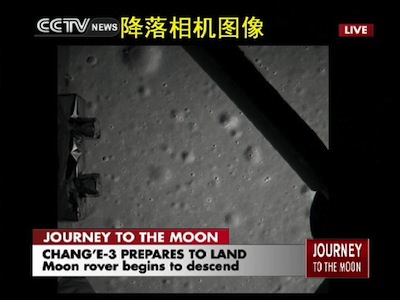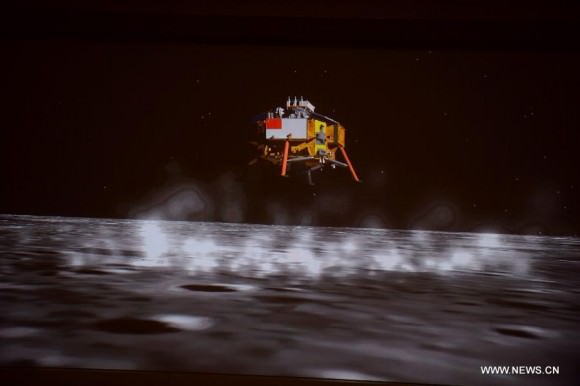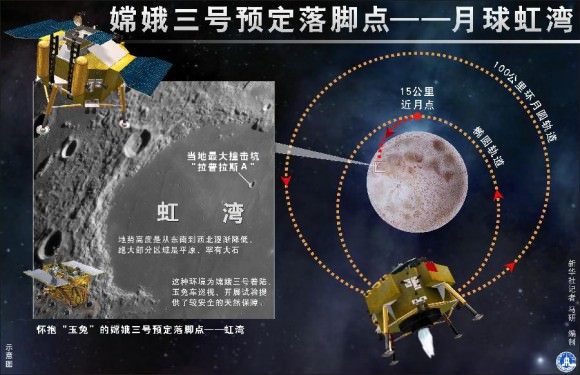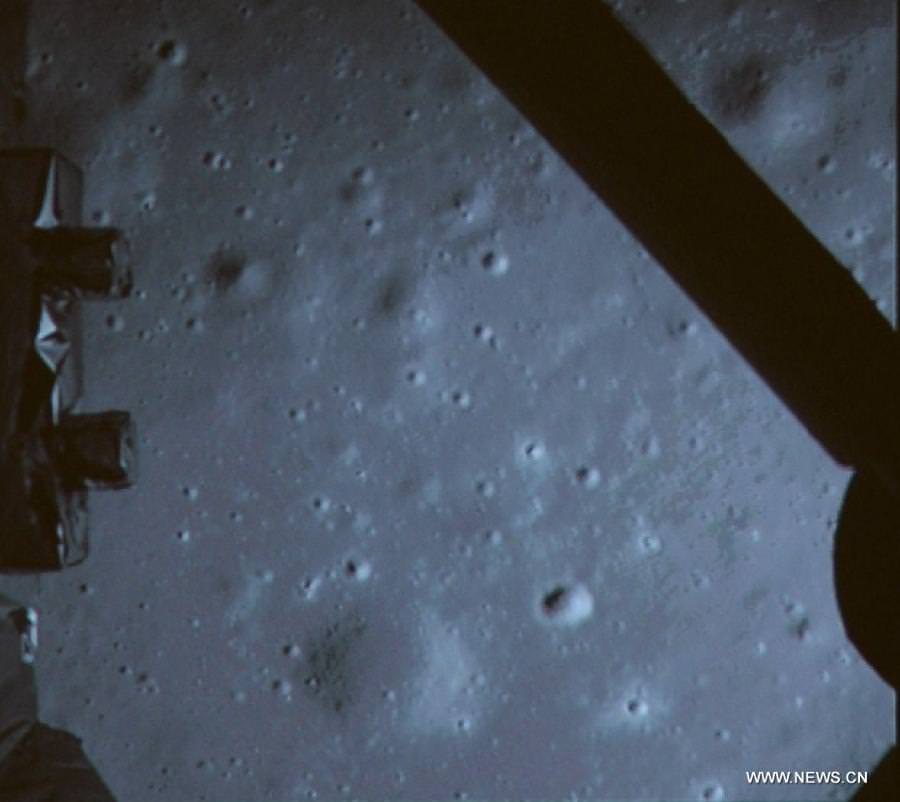Photo taken on Dec. 14, 2013 shows a picture of the moon surface taken by the on-board camera of lunar probe Chang’e-3 on the screen of the Beijing Aerospace Control Center in Beijing. This marks the first time that China has sent a spacecraft to soft land on the surface of an extraterrestrial body. Credit: Xinhua/CCTV
Story updated[/caption]
China scored a stunning, history making success with the successful touchdown of the ambitious Chang’e-3 probe with the ‘Yutu’ rover on the surface of the Moon today, Dec. 14, on the country’s first ever attempt to conduct a landing on an extraterrestrial body.
The dramatic Chang’e-3 soft landing on the lava filled plains of the Bay of Rainbows occurred at about 8:11 am EST, 9:11 p.m. Beijing local time, 1311 GMT today.
The monumental feat is the first landing on the Moon by any entity in nearly four decades. It was broadcast live on CCTV, China’s state run television network.
Note: Read my related new story with a photo gallery of Yutu’s 6 wheels rolling onto lunar soil – here
This maiden Chinese moon landing marks a milestone achievement for China and clearly demonstrates the country’s technological prowess.
 A tidal wave of high fives was unleashed by the huge teams of Chinese space engineers teams controlling the flight from the Beijing Aerospace Control Center (BACC).
A tidal wave of high fives was unleashed by the huge teams of Chinese space engineers teams controlling the flight from the Beijing Aerospace Control Center (BACC).
There was also a huge sense of relief from the nail biting tension upon confirmation of the successful soft landing following many years of hard work and intense planning.
The Chang’e-3 mission entails the first soft landing on the Moon by anyone since the Soviet Union’s unmanned Luna 24 sample return vehicle touched down back in 1976.

China now joins an elite club of three, including the United States, who have mastered the critical technology required to successfully touch down on Earth’s nearest neighbor.
China’s space vision also stands in total contrast to the utter lack of vision emanating from so called political leaders in Washington, DC who stymie NASA and US science at every opportunity!
‘Yutu’ could very well serve as a forerunner for testing the key technologies required for a Chinese manned lunar landing in the next decade.
In one of its first acts from the surface, the landers life giving solar panels were deployed as planned within minutes of touchdown
The Chang’e-3 mission is comprised of China’s ‘Yutu’ lunar lander riding piggyback atop a much larger four legged landing vehicle.
The Chang’e-3 lander transmitted its first images of the moon in real time during its approach to the lunar surface during the final stages of the ongoing landing operation carried live by CCTV.
A total of 59 images were received instead of the 10 expected, said a CCTV commentator.
The voyage from the Earth to the Moon began 12 days ago with the flawless launch of Chang’e-3 atop China’s Long March 3-B booster at 1:30 a.m. Beijing local time, Dec. 2, 2013 (12:30 p.m. EST, Dec. 1) from the Xichang Satellite Launch Center, in southwest China.
Chang’e-3 made a rocket powered descent to the Moon’s surface today by firing the landing thrusters starting at the altitude of 15 km (9 mi) for a soft landing targeted to a preselected area on the Bay of Rainbows.
The powered descent was autonomous and took about 12 minutes.
The variable thrust engine can continuously vary its thrust power between 1,500 to 7,500 newtons. It was the biggest ever used by China in space said a commentator on CCTV.
The variable thrust engine enabled Chang’e-3 to reduce its deceleration as it approached the moon.
The descent was preprogrammed and controlled by the probe itself, not from the ground.
A descent camera was mounted on the lander’s belly
The 1200 kg lander is equipped with unprecedented terrain recognition equipment and software to hover above the landing site and confirm it was safe. This enabled the craft to avoid rock and boulder fields that could spell catastrophe even in the final seconds before touchdown if the vehicle were to land directly on top of them.
The descent engine fired until the lander was about hovering 100 meters above the lunar surface.
After determining it was safe to proceed, the lander descended further to about 3 meters. The engine then cut off and the lander free fell the remaining distance. The impact was cushioned by shock absorbers.
The solar panels soon unfurled. They are the most efficient Chinese solar panels available, said a CCTV commentator.
The Bay of Rainbows, or Sinus Iridum region, is located in the upper left portion of the moon as seen from Earth. You can see the landing site with your own eyes.
It was imaged in high resolution by China’s prior lunar mission – the Chang’e-2 lunar orbiter – and is shown in graphics herein.
The Yutu rover is also unfurling its solar panels and mast today.
Yutu, which translates as Jade Rabbit, stands 150 centimeters high, or nearly 5 feet – human height.
It weighs approximately 120 kilograms and sports a robotic arm equipped with advanced science instruments.
On Sunday, the six-wheeled ‘Yutu’ rover with a rocker bogie suspension similar to NASA’s Mars rovers will be lowered in stages to the moon’s surface in a complex operation and then drive off a pair of landing ramps to explore the moon’s terrain for at least three months.
In what promises to be a space spectacular, the lander and rover are expected to photograph one another soon after Yutu rolls onto the Bay of Rainbows.
They will work independently.
The rover and lander are equipped with multiple cameras, spectrometers, an optical telescope, ground penetrating radar and other sensors to investigate the lunar surface and composition.
The radar instrument installed at the bottom of the rover can penetrate 100 meters deep below the surface to study the Moon’s structure and composition in unprecedented detail, according to Ouyang Ziyuan, senior advisor of China’s lunar probe project, in an interview on CCTV.
The Chang’e-3 lander is powered by a combination of solar arrays and a nuclear battery said CCTV, in order to survive the two week long lunar nights.
Chinese space officials expect the lander will function a minimum of 1 year.
ESA’s network of tracking stations are providing crucial support to China for Chang’e-3 from launch to landing.
China’s Chang’e-3 probe joins NASA’s newly arrived LADEE lunar probe which entered lunar orbit on Oct. 6 following a spectacular night time blastoff from NASA’s Wallops Flight Facility in Virginia.
Stay tuned here for Ken’s continuing Chang’e-3, LADEE, MAVEN, MOM, Mars rover and more news.



YES!
The will to win, the desire to succeed, the urge to reach your full potential… these are the keys that will unlock the door to personal excellence.
– Confucius
Hi Ivan,
True, but the bar was raised to putting footprints and buggy tyre tracks on the Moon four decades ago. The Chinese have some way to go to catch up.
Lunar Rover
Maybe so, but while the American hare is snoozing, the Chinese tortoise is catching up:
America vs. China looking more like a tortoise-and-hare race.
Opposed to an asteroid mission.
I can now go outside point my telescope to the Moon and see the landing site with my own eyes. It is more captivating than an asteroid mission.
And in important American news one of the Kardashians is getting a divorce.
It’s truly unfortunate the USA is the only country half serious about exploring the space.
USA (1984-present)
Note: “First” denotes a World-wide First.
1984: First untethered spacewalk
1986: First Uranus flyby
1989: First Neptune flyby
1990: First photograph of the whole solar system
1990: Optical orbital observatory
1991: First asteroid flyby
1992: First polar orbit around the Sun
1995: First orbit of Jupiter
1995: First mission into the atmosphere of a gas giant
1997: First operational rover on another planet (Mars)
2000: First orbiting of an asteroid
2001: First landing on an asteroid
2001: Mars Odyssey successful launch
2004: First orbit of Saturn
2004: First sample return beyond lunar orbit (solar wind)
2004: Spirit and Opportunity successfully lands on Mars
2005: First soft landing on Titan
2006: First sample return from comet
2006: Kepler Mission is launched, first space telescope designated to search for Earth-like exoplanets
2006: Phoenix probe successfully lands on Mars
2011: First orbit of Mercury
2012: Curiosity Mars rover lands successfully
2013: First manmade probe in interstellar space.
February 2015: Dawn reaches Vesta and Ceres.
July 2015: New Horizons reaches Pluto
July 2016: Juno Reaches Jupiter
2018: Mars Astrobiology Explorer-Cacher launched
2018: James Webb telescope launched, 6x larger than world’s currently #1 Hubble
2020: Europa Jupiter System Mission – Laplace Launched
2020: Mars Rover Launched
2020: Mars sample return mission successful
2024: Solar Probe Plus launched
2025: First successful manned exploration of near-Earth asteroids
2029: Titan Saturn System Mission
2035: First successful manned Mars mission, astronauts returned to Earth safely
First moon image?
https://twitter.com/elakdawalla/status/411875676459778049/photo/1
Why is the moon brown and pink? I know it’s the Bay of Rainbows, and all that, but I doubt that is what a human would see. Have they turned up the colour contrast? It’s a sensible thing to do, but it would be nice to know what we are looking at.
It is taken by the lander web cam live. I don’t think that these are colour calibrated and really HD.
It’s truly unfortunate the USA is the only country half serious about exploring the space..
USA (1984-present)
Note: “First” denotes a World-wide First.
1984: First untethered spacewalk
1986: First Uranus flyby
1989: First Neptune flyby
1990: First photograph of the whole solar system
1990: Optical orbital observatory
1991: First asteroid flyby
1992: First polar orbit around the Sun
1995: First orbit of Jupiter
1995: First mission into the atmosphere of a gas giant
1997: First operational rover on another planet (Mars)
2000: First orbiting of an asteroid
2001: First landing on an asteroid
2001: Mars Odyssey successful launch
2004: First orbit of Saturn
2004: First sample return beyond lunar orbit (solar wind)
2004: Spirit and Opportunity successfully lands on Mars
2005: First soft landing on Titan
2006: First sample return from comet
2006: Kepler Mission is launched, first space telescope designated to search for Earth-like exoplanets
2006: Phoenix probe successfully lands on Mars
2011: First orbit of Mercury
2012: Curiosity Mars rover lands successfully
2013: First manmade probe in interstellar space.
February 2015: Dawn reaches Vesta and Ceres.
July 2015: New Horizons reaches Pluto
July 2016: Juno Reaches Jupiter
2018: Mars Astrobiology Explorer-Cacher launched
2018: James Webb telescope launched, 6x larger than world’s currently #1 Hubble
2020: Europa Jupiter System Mission – Laplace Launched
2020: Mars Rover Launched
2020: Mars sample return mission successful
2024: Solar Probe Plus launched
2025: First successful manned exploration of near-Earth asteroids
2029: Titan Saturn System Mission
2035: First successful manned Mars mission, astronauts returned to Earth safely
1969
Well done China. Fantastic job. One Giant Step For the New Boys On The Block
The Chinese have it right. The Moon is the place to go. Mar is a good long-term goal, but there is a lot of science and resources on the Moon. When the USA decided to go to Mars first, it was just a wild hail Mary pass attempt if you ask me. It has got to cost at least twice as much to go to Mars. The Moon would make a good base for further missions, resources, and, to those who say the Moon is uninhabitable . . . . you forgot about the lava tunnels. The atmosphere of mars is not much better than that of the moon. The Moon has a much better escape velocity . . . it would make a better base for further operations.
I think it is a mistake to confuse fundamental science investigations with colonization. For all the talk of colonization, essentially all of the current solar system exploration falls into the first category. Considering this, NASA’s and ESA’s shift away from the moon makes sense. Scientists tend to target the “low hanging fruit” and after the extensive scientific investigations of the apollo missions, many of the easiest scientific questions about the moon had already been answered. Mars was and the outer solar system were the natural next target. As some of the basic questions are answered about these bodies as well, the moon again becomes a tempting target, especially for countries which are still developing their space programs. Neither represent a “right” or “wrong” approach.
If an alien race landed on 6 different places on Earth and take some ground samples, do you actually think that that Alien race has a good understanding of Earth?
At this moment we know far more about Mars than our closest moon.
And that’s bad how? There are much more interesting discoveries awaiting us on Mars, Titan, Europa, etc. As I said above, let China continue down the path of further Moon exploration and colonization. Their space program is in its infancy, and the moon is a worthwhile goal.
Is there any planet or moon in the solar system
who’s surface is composed of cocaine or heroin?
I’d like to visit there.
Even now, 40 years after the apollo missions, the number of new scientific publications about the moon exceed those about mars. Why? Because the moon had trained geologists roving around its surface in person, and they returned the samples their most interesting samples to earth, where they are still subject to fresh analysis. The pinnacle of unmanned exploration is sample return. No samples have ever been returned from Mars, while hundreds of Kg of carefully selected samples have been returned from the Moon. Scientific understanding of the moon far exceeds that of Mars.
False.
40 years ago, even with boots on the ground (moon i mean), everyone thought there was no water on the moon. We know better now with the latest missions. The Chinese mission will greatly expend our knowledge. Good luck to them and their contributions to mankind.
If an alien race landed in Arizona,
Obama would grant them Amnesty.
I would guess a trip to Mars costs much more than twice as much as a trip to Luna.
I don’t think beggars can be choosers, at least with respect to the U. S. Space program. With funding continually cut, I’d much rather see a more robust probe and rover program to Titan, Enceladus and Europa than setting up a Moon base. IMHO, we can learn much more from these types of missions than camping on the moon. Let China and India compete to achieve that goal.
Think of the advances in cosmology and exoplanet study made by Hubble, Kepler, Herschel etc., then think what could be seen by a very large telescope on the moon. If you want to mine asteroids where’s the best place to ship big chunks to be processed without risking a Terran extinction event? A beanstalk is feasible on the moon with current technology, you could use it as a base to assemble a manned Mars lander or even a starship, all you need is a base there and you have the keys to the solar system.
Mars has potential to be habitable. The Moon is mathematically uninhabitable.
Your ignorance is sick! Kill yourself.
You still have to inhabit mars inside of a sealed space vehicle. You can do that on the moon too. After all they did live on the moon in a space vehicle for a number of days.
WAY double extre groovy cool! Translate that into ??? (Good job! Hen Hao! And WOW!) Welcome to ‘the club’ China!
I wonder if anyone in DC is watching?
Competition is good. Who wants to join the space race?
2013: China soft-lands a rover on the Moon
2017: China returns a lunar soil sample
2020: China constructs its first large space station
2025: China lands a taikonaut on the Moon
2050: China lands a taikonaut on Mars
United States of America
2013: First manmade probe in interstellar space.
2006: Phoenix Probe lands on Mars
1969: Neil Armstrong and Edwin Aldrin of Apollo XI spend 21 hours on the moon, 2 of those outside the capsule.
china
2013 soft rover on moon
This news recently about a rover on the Moon brings nothing but embarrassment to the country that is funding such a project, while the United States of America is set to complete a manned mission to Mars in a little over a decade.
“2018: Mars Astrobiology Explorer-Cacher launched”
“2020: Mars sample return mission successful”
Back to the future??
Can I borrow your spaceship?
Timelines never survive reality. In the late 90s China was predicting an operational Lunar base by 2009.
I’ve heard that before. Where is your source for that?
Its called history. If you followed the course of Chinese development you would have seen it. I don’t keep old copies of China Daily. However, I do have a ?copy? of Astronautics Plan 863-2. Section 863-204 is a good example of what happens to timelines when reality hits.
Ever read the Chinese Academy of Sciences “Technological Revolution and China’s Future-Innovation 2050” ?
But then it happens to everyone. NASA was to have launched a lunar orbiting space station in 2008-2009 to support the creation of a permanently manned moonbase by 2009-2010.
NASA scientists have been talking about LAVA for decades. But the very tracks made by this and all previous rovers and astronauts prove this is not a lava flow. There is no lava on the Moon. Sir Fred Hoyle wrote “The flat floors of the lunar maria.are generally believed to be caused by the gushing out of molten rock from the regions below the solid crust. This picture would essentially have been proved if visits to the lunar maria had revealed the presence of extensive lava beds. But no astronaut has ever stood upon a lava bed. .Lava flows have been found only in the imagination of those who have examined distant photographs taken from the Apollo landing sites. What astronauts actually found was a great deal of fine powder. Embedded or lying on the powdery surface was a multitude of rock fragments. Subsequent chemical analysis of which showed them to be of highly variable chemical composition, making it quite unlikely that they were fragments of a single coherent flow of molten rock.”
Wow!!
Some accomplishment!
China has now reached the level the U.S.A. reached in 1964.
What now?
Is China going to actually build a car?
When the Little Green Men on the moon was the Chinese probe land,
they approached it and ordered eggroll, pork fried rice, lo mein,
and shrimp chow mein with no MSG.
Congratulations to China, but the bias in this article is HILARIOUS.
China is doing something the USA did nearly 50 years ago!!!!
It’s truly unfortunate the USA is the only country half serious about exploring the space.
USA (1984-present)
Note: “First” denotes a World-wide First.
1984: First untethered spacewalk
1986: First Uranus flyby
1989: First Neptune flyby
1990: First photograph of the whole solar system
1990: Optical orbital observatory
1991: First asteroid flyby
1992: First polar orbit around the Sun
1995: First orbit of Jupiter
1995: First mission into the atmosphere of a gas giant
1997: First operational rover on another planet (Mars)
2000: First orbiting of an asteroid
2001: First landing on an asteroid
2001: Mars Odyssey successful launch
2004: First orbit of Saturn
2004: First sample return beyond lunar orbit (solar wind)
2004: Spirit and Opportunity successfully lands on Mars
2005: First soft landing on Titan
2006: First sample return from comet
2006: Kepler Mission is launched, first space telescope designated to search for Earth-like exoplanets
2006: Phoenix probe successfully lands on Mars
2011: First orbit of Mercury
2013: First manmade probe in interstellar space.
February 2015: Dawn reaches Vesta and Ceres.
July 2015: New Horizons reaches Pluto
July 2016: Juno Reaches Jupiter
2018: Mars Astrobiology Explorer-Cacher launched
2018: James Webb telescope launched, 6x larger than world’s currently #1 Hubble
2020: Europa Jupiter System Mission – Laplace Launched
2020: Mars sample return mission successful
2024: Solar Probe Plus launched
2025: First successful manned exploration of near-Earth asteroids
2029: Titan Saturn System Mission
2035: First successful manned Mars mission, astronauts returned to Earth safely
Thanks to the Clinton’s selling america out once again were the chi-comms able to do this.
Keep censoring me. How pathetic.
Not censoring, it’s just that some IP addresses have been blacklisted because of spam; consequently, some innocuous comments get caught in moderation. Nothing personal, dude.
Thank you.